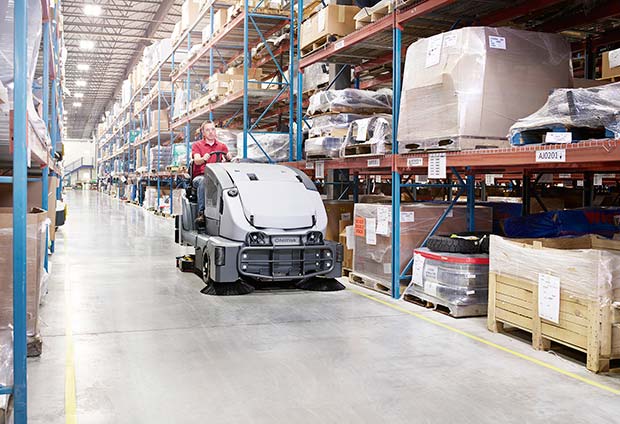The evidence is clear – cleaner, less cluttered facilities outperform dirty ones. Cleaner warehouses are simply more productive, safer and better organised. Cleanliness is also known to aid employee attitudes, ongoing industry issues with staff retention therefore make cleaning doubly important.
 Health and safety of course remains critical, debris and spillages are unavoidable presenting a constant risk to personnel and the public. Product spillages can be anything from sugar to oil and grease and pallet strapping is a challenge for us all. Only professional cleaning will remove all substances safely. How best to achieve that in a timely and cost efficient manner?
Health and safety of course remains critical, debris and spillages are unavoidable presenting a constant risk to personnel and the public. Product spillages can be anything from sugar to oil and grease and pallet strapping is a challenge for us all. Only professional cleaning will remove all substances safely. How best to achieve that in a timely and cost efficient manner?
Inventory Risk
Additionally of course dirt and dust can be hugely detrimental to inventory. Dust will quickly collect on top of pallets and racking potentially infiltrating packaging and causing costly stock loss. Perpetual dust also creates a problem with air quality increasing staff sickness rates and absenteeism.
Productivity Focus
With constant pressure on margins and labour costs rising there has to be an ongoing focus on cost effective methods of cleaning. Savvy managers are now focusing on ‘Total Cost of Ownership’ a process of examining all elements; labour, power, water, chemical and maintenance dramatically decreasing costs and improving the bottom line.
The right cleaning equipment, working well will certainly make a difference on all levels and should also be an enjoyable drive.Definitely better than spreading some dirty water around on the floor – also known as mopping!
To Sweep – To Scrub – Or Both?
The first issue to be addressed is sweeper only, scrubber dryer only or a combined sweeper/scrubber that will complete the job in one pass.
Most machines come in a variety of cleaning widths so consideration needs to be given to the size of the aisles and the type of debris on the floor. A large industrial sweeper will make quick work of loose debris but the floor surface may still be left dirty creating slips and trips risks. Swapping over to a second scrubber dryer will delay the process and of course there is the issue of 2 machines to be funded and stored.
A combined sweeper/scrubber dryer is an obvious answer, new models such as the new Nilfisk CS7010 are a far cry from machines of yesteryear and come with an impressive technical specification. Technical spec aside however, what benefits can we bring to the user?
User Benefits
Nilfisk innovations including SmartFlow™ and Ecoflex™ technology mean that the CS7010 uses less water and chemical than other machines. This increases productivity considerably using less time to dump and refill. The battery powered models run up to 5.4 hours in combined sweeping & scrubbing mode – no down time.
The optional Dustguard™ system sprays a fine mist during sweeping minimising airborne dust and improving air quality for the team. Nilfisk have pioneered the ‘No- Tool’ ™ system enabling simple, quick replacement of squeegees, brushes, brooms and blades. Similarly the tilt out/lift off recovery tank makes cleaning out easy – maximum access with no tools. The front dry sweeper debris hopper benefits from a high lift system and has a huge capacity of 198 litres.
The CS7010 also boasts a Onetouch™ graphic display user interface with simple light touch controls. Enhanced diagnostics and a soft touch steering wheel comes as standard, It really could not be easier!
Fuel Options
The CS7010 combined sweeper scrubber, with a cleaning width of 1245 mm, is available in LPG/Hybrid, Diesel/Hybrid and ePower Battery. The award winning, eco-friendly design dispels the complexity and high maintenance of hydraulic systems, eliminating hydraulic reservoirs, filters and 98% of leak prone hoses, pumps, motors & valves. Simply more time to get the job done and less hassle.
Nilfisk is one of the world’s largest manufacturers of commercial and industrial cleaning equipment. No obligation site surveys and demonstrations are available across the UK.
NILFISK




Comments are closed.